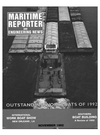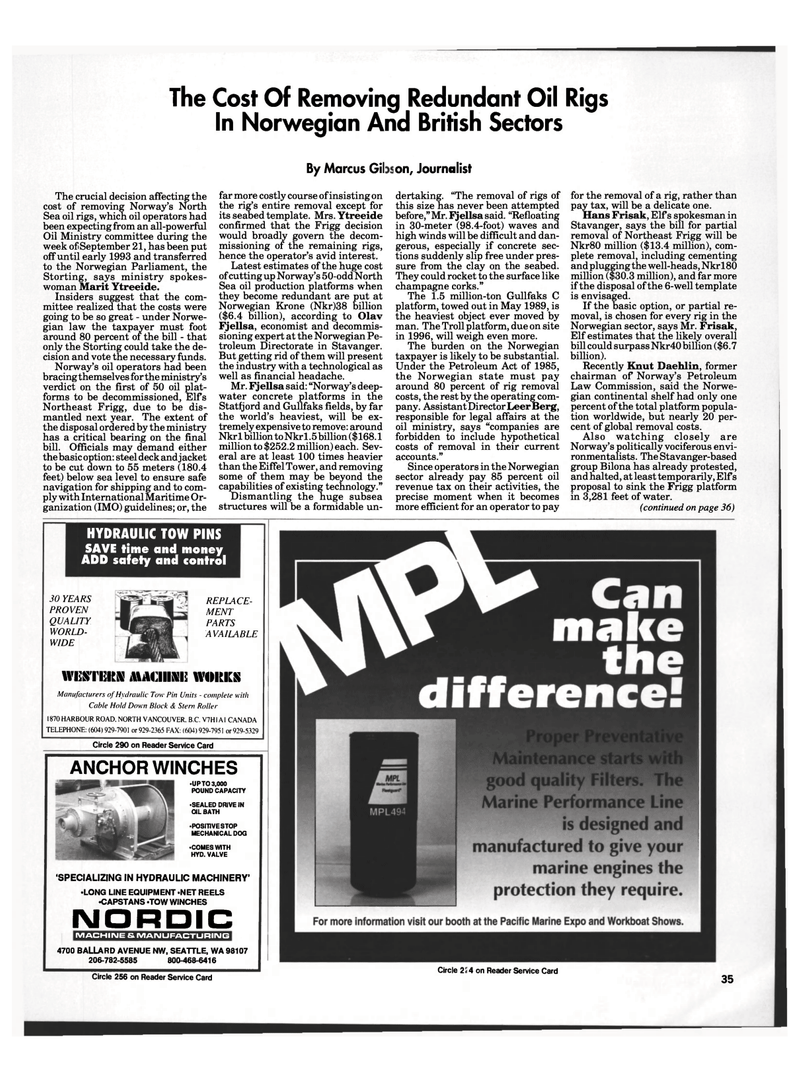
Page 33: of Maritime Reporter Magazine (November 1992)
Read this page in Pdf, Flash or Html5 edition of November 1992 Maritime Reporter Magazine
The Cost Of Removing Redundant Oil Rigs
In Norwegian And British Sectors
The crucial decision affecting the cost of removing Norway's North
Sea oil rigs, which oil operators had been expecting from an all-powerful
Oil Ministry committee during the week of September 21, has been put off until early 1993 and transferred to the Norwegian Parliament, the
Storting, says ministry spokes- woman Marit Ytreeide.
Insiders suggest that the com- mittee realized that the costs were going to be so great - under Norwe- gian law the taxpayer must foot around 80 percent of the bill - that only the Storting could take the de- cision and vote the necessary funds.
Norway's oil operators had been bracing themselves for the ministry's verdict on the first of 50 oil plat- forms to be decommissioned, Elfs
Northeast Frigg, due to be dis- mantled next year. The extent of the disposal ordered by the ministry has a critical bearing on the final bill. Officials may demand either the basic option: steel deck and j acket to be cut down to 55 meters (180.4 feet) below sea level to ensure safe navigation for shipping and to com- ply with International Maritime Or- ganization (IMO) guidelines; or, the
By Marcus Gil far more costly course of insisting on the rig's entire removal except for its seabed template. Mrs. Ytreeide confirmed that the Frigg decision would broadly govern the decom- missioning of the remaining rigs, hence the operator's avid interest.
Latest estimates of the huge cost of cutting up Norway's 50-odd North
Sea oil production platforms when they become redundant are put at
Norwegian Krone (Nkr)38 billion ($6.4 billion), according to Olav
Fjellsa, economist and decommis- sioning expert at the Norwegian Pe- troleum Directorate in Stavanger.
But getting rid of them will present the industry with a technological as well as financial headache.
Mr. Fjellsa said: "Norway's deep- water concrete platforms in the
Statfjord and Gullfaks fields, by far the world's heaviest, will be ex- tremely expensive to remove: around
Nkrl billion to Nkr 1.5 billion ($168.1 million to $252.2 million) each. Sev- eral are at least 100 times heavier than the Eiffel Tower, and removing some of them may be beyond the capabilities of existing technology."
Dismantling the huge subsea structures will be a formidable un- on, Journalist dertaking. "The removal of rigs of this size has never been attempted before," Mr. Fjellsa said. "Refloating in 30-meter (98.4-foot) waves and high winds will be difficult and dan- gerous, especially if concrete sec- tions suddenly slip free under pres- sure from the clay on the seabed.
They could rocket to the surface like champagne corks."
The 1.5 million-ton Gullfaks C platform, towed out in May 1989, is the heaviest object ever moved by man. The Troll platform, due on site in 1996, will weigh even more.
The burden on the Norwegian taxpayer is likely to be substantial.
Under the Petroleum Act of 1985, the Norwegian state must pay around 80 percent of rig removal costs, the rest by the operating com- pany. Assistant Director Leer Berg, responsible for legal affairs at the oil ministry, says "companies are forbidden to include hypothetical costs of removal in their current accounts."
Since operators in the Norwegian sector already pay 85 percent oil revenue tax on their activities, the precise moment when it becomes more efficient for an operator to pay for the removal of a rig, rather than pay tax, will be a delicate one.
Hans Frisak, Elfs spokesman in
Stavanger, says the bill for partial removal of Northeast Frigg will be
Nkr80 million ($13.4 million), com- plete removal, including cementing and plugging the well-heads, Nkr 180 million ($30.3 million), and far more if the disposal of the 6-well template is envisaged.
If the basic option, or partial re- moval, is chosen for every rig in the
Norwegian sector, says Mr. Frisak,
Elf estimates that the likely overall bill could surpass Nkr40 billion ($6.7 billion).
Recently Knut Daehlin, former chairman of Norway's Petroleum
Law Commission, said the Norwe- gian continental shelf had only one percent of the total platform popula- tion worldwide, but nearly 20 per- cent of global removal costs.
Also watching closely are
Norway's politically vociferous envi- ronmentalists. The Stavanger-based group Bilona has already protested, and halted, at least temporarily, Elfs proposal to sink the Frigg platform in 3,281 feet of water. (continued on page 36)
HYDRAULIC TOW PINS
SAVE time and money
ADD safety and control 30 YEARS
PROVEN
QUALITY
WORLD-
WIDE
REPLACE-
MENT
PARTS
AVAILABLE uwriMN auciiixi: mmis
Manufacturers of Hydraulic Tow Pin Units - complete with
Cable Hold Down Block & Stern Roller 1870 HARBOUR ROAD. NORTH VANCOUVER. B.C. V7HI Al CANADA
TELEPHONE: (604)929-7901 or929-2365 FAX: (604)929-7951 or929-5329 35 Circle 284 on Reader Service Card 35
MACHINE Sl MANUFACTURING
Circle 290 on Reader Service Card
Circle 256 on Reader Service Card 4700 BALLARD AVENUE NW, SEATTLE, WA 98107 206-782-5585 800-468-6416
ANCHOR WINCHES •UP TO 3,000
POUND CAPACITY •LONG LINE EQUIPMENT -NET REELS •CAPSTANS »TOW WINCHES
NORDIC •SEALED DRIVE IN
OIL BATH •POSITIVE STOP
MECHANICAL DOG •COMES WITH
HYD. VALVE 'SPECIALIZING IN HYDRAULIC MACHINERY'

 32
32

 3rd Cover
3rd Cover
